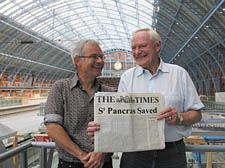|
|
 |
| |

Dramatic story: Playwright Richard Shannon and actor Julian Glover at the new St Pancras |
On stage... how Betjeman saved St Pancras from the bulldozers
THE dramatic story of how St Pancras station was just days from being bulldozed is due to be told in the shadow of the restored rail terminus.
All Our Hellos and Goodbyes, by playwright Richard Shannon and starring actor Julian Glover, dramatises events in the autumn of 1967 leading up to the decision that could have seen William Barlow’s station demolished.
Advanced plans were laid to raze the station and replace it with a sports centre, car park and hospital – until Sir John Betjeman stepped in.
The poet laureate was so shocked at the proposals that he launched a campaign to press the Greater London Council, Camden Council, British Rail and Whitehall to ditch the plans and to give the building Grade-I listed status.
Mr Shannon meticulously researched the build-up to the St Pancras listing. What emerged is a dramatic story of how one of London’s finest examples of Victorian design was just hours from being knocked down.
Until Betjeman lobbied the government to give the 1860s building Grade-I status, there was little to stop bulldozers moving in.
Mr Shannon spent weeks researching Betjeman’s campaign. He said: “I read all I could about John Betjeman – his poetry, his letters and biographies, and I was also helped by his daughter, Candida Lycett-Green.
“But my real breakthrough was trawling the National Archives at Kew, where I saw all the government papers relating to St Pancras.”
The last-minute campaign to save St Pancras kick-started a new appreciation of the architectural heritage of the 1800s.
Julian Glover, who plays Betjeman in the show, said the poet’s influence on how we view our architectural heritage should not be under-estimated.
He added: “It can feel like it does not matter how much the public protests, governments and councils will hold inquiries, ask for views and then build anyway. There was opposition to knocking down St Pancras, but Sir John made this a nationwide issue.
“The government were prepared to demolish the nation’s heritage, but Betjeman’s public profile meant he could attract attention to what was happening.
“At the time, Victoriana was considered to be old-fashioned and defunct. Betjeman said this is wrong.
“He urged people to consider what Victorian buildings meant and what they represented. This fight to save St Pancras represented a watershed in the way we consider Victorian London.”
Mr Glover, a student at Rada drama school in the early 1960s, remembers when the old Euston station was demolished, including the arch whose loss has long been mourned by preservation societies.
He said: “I remember the Euston Arch coming down and the realisation afterwards that something terrible had happened.
“British Rail wanted the same at St Pancras – a new modernist station that said we are cutting edge with our exciting new electrified railway and a station to match. Instead, because of Betjeman, the brilliance of the Victorian railway age was preserved.”
* |
 |
|
| |
| Your Comments: |
| |
| |
| |
|
 |
|